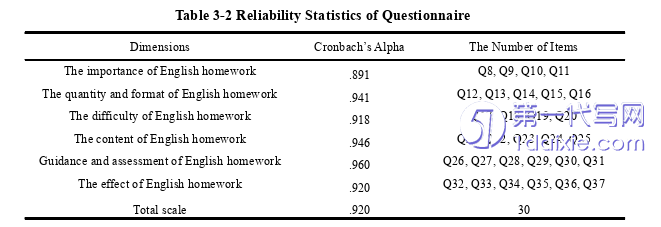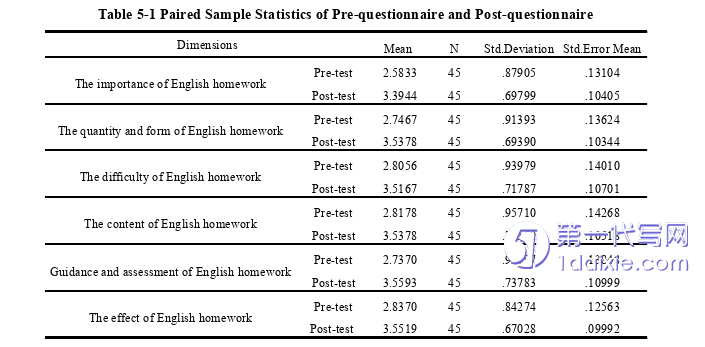本文是一篇英语论文,本次行动研究为今后的初中英语分层家庭作业设计提供以下借鉴:首先,教师应采取动态分层的方式对学生进行分层。其次,分层作业的设计要以学生为中心,教师应根据学生的学习水平差异,设计符合他们最近发展区的分层作业,激发学生的对英语家庭作业的兴趣,从而提升他们的学习能力。
Chapter 1 Introduction
1.1 Background of the Research
Homework is an extension of classroom teaching,enabling students to consolidatetheir knowledge and allowing teachers to promptly identify learning issues.In China,since the release of the Opinions,schools have been placing more and more emphasison students’homework.And the Opinions outline specific measures to alleviatehomework and extracurricular training burdens for compulsory education students,including reducing homework quantity and duration,specifying homework categoriesand amounts,improving homework design quality,and promoting differentiated,flexible,and personalized homework assignments while eliminating mechanical,ineffective,repetitive,and punitive homework.
Despite these efforts,junior high school English homework assignments still posenumerous challenges and difficulties.In traditional English teaching classes,teachersoften let students memorize words,texts,and language knowledge points.Studentsrecite mostly by rote,but different students have different physical and mentaldevelopment characteristics and ability levels,teachers’“one-size-fits-all”homeworkassignment mode of homework content lacks deep excavation and thinking,andteachers rarely guide students to analyze and evaluate the content of the homework indepth,so students do not purposefully process and create the knowledge what they havelearned and do not have a purposeful processing and creation of the knowledge theyhave learned as well.Over time,mechanical repetition causes students to lose interest in English learning,leading to a decline in performance.

1.2 Purpose of the Research
This study integrates the“Double Reduction”policy with junior high schoolEnglish education,emphasizing action research on English differentiated homeworkwithin the context of this policy.Leveraging Bloom’s Taxonomy of EducationalObjectives(revised),Multiple Intelligences theory,and Zone of Proximal Developmenttheory,the research analyzed the data which collected through questionnaire,interviews,student reflection journal,teaching reflection journal,and tests.Furthermore,typicalhomework designs were cited to summarize strategies for designing Englishdifferentiated homework that can enhance students’interest in and proficiency in thesubject,while also alleviating their homework burden under the“Double Reduction”policy.Additionally,the study optimized the approach to English differentiatedhomework design,identified challenges encountered,and continuously adjustedstrategies.This provides front-line English teachers in compulsory education with novelmethods and ideas for designing English differentiated homework,serving as a valuablereference for researchers in the field of English teaching.
Chapter 2 Literature Review
2.1 Definition of Key Words
To make this article more accurate,in this section,the Definitions of Homework,Differentiated Homework,English Differentiated Homework and the“DoubleReduction”policy will be defined in this study.
2.1.1 Homework
Homework,a ubiquitous concept in education,remains challenging to define dueto its diverse manifestations.Devine(1987)offered a perspective from abroad,describing homework as a learning task undertaken by students without direct teacher’sguidance.However,this definition lacks specificity.Cooper Harris(1994),a renownedscholar in the United States specializing in homework research,provided a moredetailed definition.He viewed homework as a learning task assigned by teachers thatstudents are expected to complete either at school or at home,utilizing theirout-of-school time.This definition highlights the role of teachers in structuringhomework and the requirement for students to engage with it independently.Furthermore,Cooper Harris(2001)expanded on this concept,defining homework asactivities and tasks assigned by teachers to students that are meant to be completedduring non-instructional time.This definition emphasizes the distinction betweeninstructional and non-instructional time,highlighting the supplementary nature ofhomework in supporting students’learning.Collectively,these definitions reveal themultifaceted nature of homework,encompassing various aspects such as teacherinvolvement,student autonomy,and the utilization of out-of-school time.While nosingle definition can capture all its nuances,these perspectives provide valuable insightsinto the construct of homework and its role in education.
2.2 Previous Research on Differentiated Homework at Home andAbroad
Since 2021,“differentiated homework”has received close attention fromacademics under the promotion of the“Double reduction”policy.Based on the resultsof the literature search,there were a few studies on differentiated homework at homeand abroad,but most of them focused on theoretical research,and there were not manyaction research papers on English subjects.Through sorting out the relevant literature,the research on the design of differentiated homework at home and abroad mainlyfocuses on the following three aspects:the principles of differentiated homework,theways of differentiated homework and the effectiveness of differentiated homework.
2.2.1 Previous Research on the Principles of Differentiated Homework
Based on the results of literature research,it found that there were few studies on the principles of differentiated homework abroad.The following is the researches ofsome scholars in China in recent years on the principles of differentiated homeworkdesign.
Chapter 3 Methodology .............................. 20
3.1 Research Questions .......................... 20
3.2 Participants ........................................... 20
3.3 Research Instruments ........................ 21
Chapter 4 Action Research ............................................. 26
4.1 The Preparation Stage of Action Research ...................................... 26
4.1.1 Students Stratification .............................. 26
4.1.2 Homework Stratification ........................... 27
Chapter 5 Results and Discussion ............................... 45
5.1 Results ...................................... 45
5.1.1 Results and Analysis of Pre-questionnaire and Post-questionnaire ............................ 45
5.1.2 Results and Analysis of Pre-Test and Post-test .......................... 49
Chapter 5 Results and Discussion
5.1 Results
In order to comprehensively understand the current situation of the integration ofEnglish differentiated homework into junior high school English teaching under thebackground of the“Double Reduction”policy and to make up for the shortcomings ofthe questionnaire,after each round of the action research,the author conductedinterviews with two students at each level,and at the same time test paper wasdistributed to the students.This section mainly analyzes the results of the questionnaire,the students’interviews,and the students’test scores.
5.1.1 Results and Analysis of Pre-questionnaire and Post-questionnaire
The results of the pre-questionnaire and post-questionnaire were analyzed.Thequestionnaire was given to the students before the first-round of action research as wellas after the third-round of action research in order to better understand their attitudestowards English language learning before as well as after the action research.Subsequently,the paired sample statistics of pre-questionnaire and post-questionnairewere conducted.As shown in Table 5-1.

Chapter 6 Conclusion
6.1 Major Findings of the Study
The purposes of this study are to explore how to implement English differentiatedhomework under the background of the“Double Reduction”policy,and how Englishdifferentiated homework affects students’attitudes to learning and academicperformance.Based on analyzing the data obtained from questionnaires,students’interviews,and tests,the following main conclusions were drawn:
First,during the three-month action research,the author reflected on the problemsexisting in the previous round of action research and adjusted the next action researchplan in time,which made the differentiated homework achieve the expected effect.
Second,from the students’interviews and homework completion,most of thestudents recognized the importance of differentiated homework and supported theteachers’implementation of differentiated homework.At the same time,they are moreinterested in English learning and more willing to complete their English homeworkseriously.
Third,most of the students thought that English differentiated homework wasbeneficial to their learning and achievement,so they hoped that the teacher wouldcontinue to apply differentiated homework to English teaching.However,there are stilla few students who think that the amount of English differentiated homework is toolittle to meet their learning needs and is not useful in improving their academicperformance.
reference(omitted)
